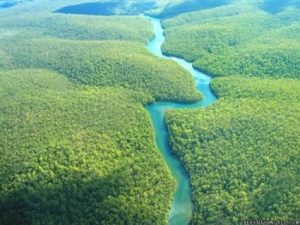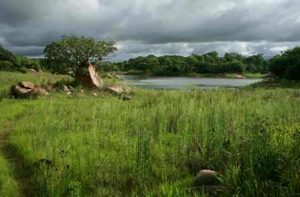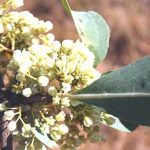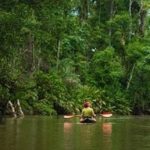TREE LIFE
October 2010
MASHONALAND CALENDAR
Sunday 17th October: Outing to Mfuti. We shall be visiting Anita and Peter Vorster’s place, Mfuti. The last time we visited here was in the winter (21 June 2009) and we had an interesting walk and found some interesting trees – for example, a colony of Albizia versicolor.
We shall meet at 9:30 a.m. Please bring a chair and your lunch.
Saturday 23rd October: Haka Game Park. One of our regular haunts. We hope to see trees in flower, and we will also look at the spring flush of herbaceous plants which should be appearing.
There will be an entrance fee, the amount of which is not known, so please come prepared. We will meet at 2.30 p.m.
Thursday 14th October: A talk about Dick Petheram
The Mashonaland Branch of the History Society of Zimbabwe will be holding a talk on the life and achievements of Richard (Dick, Pete) Petheram.
Dick Petheram was a senior civil servant in the Ministry of Lands and Natural Resources.
He combined his official career with a great personal interest in and knowledge of trees, wildlife and natural resources in general. He retired in 1968 and his contribution to our country is possibly not well known and this talk will be an opportunity to hear more about a dedicated civil servant. He was one of a group of civil servants of that era who were driven by commitment, enthusiasm and optimism. He was also Chairman of the Tree Society from about 1980-81.
The speakers will be his daughters Edone Ann Logan and Jill Frow. Jill will be coming from South Africa for the occasion. Edone Ann has contributed a number of papers to the Society journal Heritage, and has herself an interest in history and the outdoors.
The talk will be held at Prince Edward School at 5.30 p.m. on Thursday 14 October.
SEEING THE WOOD
Daybreak is a heavenly time to look on the Amazonian canopy. From a Brazilian research tower high above it, a fuzzy grey sylvan view emerges from the thinning gloom, vastly undulating, more granular than a cloud. It is mind-bendingly beautiful. Chirruping and squawking, a few early risers—collared puffbirds, chestnut-rumped woodcreepers and the tautologous curve-billed scythebill—open up for the planet’s biggest avian choir.

Amazon River and Forest. Photo: Wikipedia
In a slick of molten gold, dawn breaks and the trees awaken. In every leaf, chlorophyll molecules are seizing the day for photosynthesis. Using sunlight to ship electrons, they split water molecules and combine the resulting hydrogen with carbon dioxide extracted from the air. This produces carbohydrates that the trees turn into sugars, to be burnt off in respiration or, by another chemical process, turned into new plant matter. The main waste product, oxygen, they emit through their stomata in a watery belch. Hence the rainforest’s high level of humidity, visible from the observation tower in diaphanous cloudlets drifting over the canopy.
That plants emit oxygen has long been known—since 1774, in fact, when Joseph Priestley, a British chemist, found a mouse not too “inconvenienced” by being trapped inside a bell-jar with a mint plant. Yet the importance of plants’ ability to store carbon in making the planet habitable is still not widely appreciated. On two previous occasions when the atmosphere contained very high levels of carbon dioxide, the early Carboniferous and Cretaceous periods, beginning about 350m and 150m years ago respectively, they were reduced by the expansion of carbon-sequestering plants. Industrial burning of the fossil fuels laid down in the Carboniferous period, in the form of decaying plant matter, is the main reason why there is now more carbon in the atmosphere than there has been for 4 million years.
Carbon calculations
This is the latest reason—and it is a big one—why destroying forests is a bad idea. Roughly half the dry weight of a tree is made up of stored carbon, most of which is released when the tree rots or is burned. For at least the past 10,000 years, man has been contributing to this process by hacking and burning forests to make way for agriculture. About half the Earth’s original forest area has been cleared. Until the 1960s, by one estimate, changes in land use, which mostly means deforestation, accounted for most historic man-made emissions. And its contribution to emissions is still large: say 15-17% of the total, more than the share of all the world’s ships, cars, trains and planes.
But this underestimates the damage done by the clearance. It also discounts a geological-time-honoured way to sequester carbon. That growing forests, natural or planted, do this is obvious. But there is increasing evidence to suggest that primary, or old-growth, forests are seizing the opportunity of a carbon-heavy atmosphere to suck up more carbon than they did previously, a process known as “carbon fertilisation”. By one estimate the Amazon rain- forest is sequestering an additional 1.3 gigatonnes a year, roughly matching the recent annual emissions produced by clearing it. Across the world, forests and the soil beneath them absorb about a quarter of all carbon emissions.
This is an indispensable contribution to life as we know it, and forests offer many others, too. They house more than half the world’s species of animals, birds and insects. In the Amazon rainforest this biodiversity is staggering: even its small gullies and runnels often have unique subspecies of monkeys, birds, creatures of all kinds. Forests are also the source of most staple foods and many modern medicines. They provide livelihoods, wholly or partly, for about 400 million of the world’s poorest people. They have always touched the imaginations of more privileged ones: “A culture is no better than its woods,” wrote W.H. Auden. Indeed, the more that people learn about forests, the more perilous their mismanagement seems.
They also make rain
That forests regulate water run-off, mitigating risks of flooding and drought, has been recognised since ancient times. The ancients also understood that trees can increase rainfall and deforestation can reduce it. Cutting down trees leads to a reduction in evapotranspiration, which results in less downwind precipitation. In the case of the Amazon rainforest this has huge implications for the agriculture of the whole of the Americas. That of southern Brazil, northern Argentina and Paraguay, in particular, depends for rainfall on the moist Atlantic trade winds, which cross the Amazon basin and then are deflected southwards by the Andes. There are also indications that the American Midwest is watered from the same source, by the moisture deflected northwards. The forest, by recycling the water that falls on it through evapotranspiration, plays an important part in this system.
Between a quarter and half of the water molecules that fall in the western Amazon have previously fallen on the rainforest. In its absence, it would be reasonable to expect a corresponding decrease in regional precipitation, which would be calamitous, but the actual effect could be much worse. Two Russian physicists, Victor Gorshkov and Anastassia Makarieva, claim that forests, not temperature, are the main drivers of winds. They base this on the previously unconsidered drop in pressure that occurs when water passes from gas to liquid state in condensation. So ecosystems that maintain a moist atmosphere—as rainforest does—draw in air and moisture from elsewhere. This could explain the curious fact that precipitation in the western Amazon is higher than it is upwind, despite leakage in run-off at every revolution of the local water cycle.
The theory caused a stir in Western academia last year when it was put forward in the journal Biosphere and is considered farfetched by many. But it should reinforce the point that, on hydrological grounds alone, conserving forest is often essential.
And still they are being chopped down. According to the main compiler of forest data, the UN’S Food and Agriculture Organisation, about 4 billion hectares (10 billion acres) of forest remain, covering 31% of the Earth’s land surface. Only a third is primary. Much of the rest is seriously degraded: the FAO’S definition of a forest takes in areas with as little as 10% tree cover.
Almost half of the forest that remains is in the tropics, mostly as rainforest which, by almost any measure, is most precious of all. Nearly a third of that rainforest is in Brazil, which has two-thirds of the Amazon basin; and a fifth is in Congo and Indonesia. The second-biggest forest area, about a third of the total, is in the boreal, or taiga, biome: a belt of spruce, birch, fir and aspen that encircles the far northern hemisphere, mostly in Russia, Scandinavia, Finland, Canada and a small part of America. Just 11% of forest is in the temperate zone, dominated by America, which cleared almost half its massive forests in the 19th century, and Europe and China, which ate into theirs much earlier. Europe razed almost half its temperate oak-, beech- and birch- woods in the Middle Ages, an onslaught only briefly reversed by an outbreak of bubonic plague in the 14th century. Now temperate forests are creeping back. Over 7 million hectares a year are currently being planted or allowed to regrow, according to the FAO, mostly in China and America.
A tropical problem
The current onslaught is mainly in the tropics. In the past six decades the rainforest has been reduced by over 60% and two-thirds of what remains is fragmented, which makes it even more liable to be cleared. And despite many campaigns by NGOs, vigils and rock concerts for the rain-forest and efforts to buy it, lease it, log it and not log it, the destruction proceeds at a furious clip. In the past decade, the FAO records, around 13 million hectares of the world’s forests, an area the size of England, have been lost each year. Most of this was tropical forest, razed for agriculture. But Russia, which has more forest than any other country, also lost a lot, which the FAO’s figures do not capture because its clearance did not involve a permanent change in land use. Between 2000 and 2005 some 144,000 sq km (55,000 square miles) of Russian forest—14% of the total—was incinerated or felled, much of it illegally.
This represents progress, of a sort. In the 1990s, when the candle-holding for the rainforest was at its height, over 16 million hectares a year were lost. Most of the slowdown is because of reduced rates of clearance in the world’s biggest deforesters, Brazil and Indonesia, and to some degree this reflects their former gluttony: both have masses of cleared land to spare. But in both countries efforts to reduce the destruction have also helped, especially in Brazil, which has a fast-growing agricultural sector and is increasingly worried about deforestation. Over the past decade it has given protected status to 500,000 sq km of the Amazon rainforest. According to a recent report by the Royal Institute of International Affairs, a British think-tank, illegal logging has been greatly reduced in Brazil, Indonesia and Cameroon.
A few smaller rainforest countries are also showing more regard for their trees. Costa Rica, which in the late 1980s lost around 4% of its forest each year, has reduced its deforestation almost to zero. Gabon and Guyana, almost three-quarters of which are covered by trees, say that, with foreign help, they would be happy to keep it that way. Western consumers, increasingly sensitive to the notion of sustainability, have a small hand in these improvements. Alarmed by their bad press, Canadian timber companies announced in May this year that they would work with greens to improve the management of 72 million hectares of boreal forest.
Yet such progress tends to be exaggerated, and even if it were real it would be insufficient because of two huge threats to the forest. The first is climate change, which is expected to redraw the map of forest ecosystems. The boreal forest will creep northwards, for example, as the permafrost thaws and carbon fertilisation increases. By one estimate, Finland’s forests could grow 44% faster as a result. But that is nothing to celebrate, because melting permafrost will release billions of tonnes of methane, an especially potent greenhouse gas. It will also be offset by an increase in forest dieback elsewhere, caused by rising aridity, drought, pests and fires—all symptoms of global warming. Deforestation, which causes local warming, exacerbates this. All this could make much of the current forest area inhospitable to trees.
Such damage is already more common than most climate models had predicted, with the boreal belt especially hard hit. Between 2000 and 2005 it lost 351,000 sq km of forest, mostly to fire and pests. Again, this loss does not show up in the FAO’s figures, and the resulting emissions are considered to be natural, not man-made. But the distinction is getting blurred. Setting aside its reforestation efforts, Canada, the world’s third-most-forested country, lost 5.2% of its tree cover in that five-year period. This was partly because of a plague of bark-beetles in its temperate and boreal zones, a record number of which have been surviving the recent mild winters. By 2009 they had devastated over 16 million hectares of Canadian pine forest.
The outlook for the Amazon is also grave. Recent modelling suggests that the mutually reinforcing effects of increasing temperatures and aridity, forest fires and deforestation could bring the rainforest far closer than previously thought to “tipping points” at which it becomes ecologically unviable. So far 18% of the rainforest has been cleared. The loss of another 2%, according to a World Bank study last year, could start to trigger dieback in the forest’s relatively dry southern and south-eastern parts. A global temperature increase of 3.5%, comfortably within the current range of estimates for the end of this century, would put paid to half the rainforest. This would release much of the 50 gigatonnes of carbon it is estimated to contain—equivalent to ten years of global emissions from burning fossil fuels.
Too many hungry mouths
The second great threat is human. The Earth’s population is expected to increase by half over the next four decades, to around 9 billion, and most of the additional 3 billion-odd hungry mouths will be in developing countries, especially tropical ones. The population of Congo, now 70 million , will double in that time. Demand for food in these countries will also double, which, at their current low levels of agricultural productivity, will drive up demand for forest land.
As in most central African countries, Congo’s deforestation is currently minor, caused largely by small-scale shifting cultivation and over-harvesting of wood for fuel. At present the country has little commercial agriculture or logging because of the state of its infrastructure, ruined by war and misrule. Indeed, the decay of Congo’s Belgian-built roads, which in 1960 ran to over 100,000 km, must rank as one of the greatest boons to forests since the Black Death. In the thick forest-savannah mosaic of northern Congo, many days’ walk from any tarmac, your correspondent unearthed a milestone, half-buried in the leaf-litter, pointing to the small town of Badai, 15 km to the east. Buried deeper was the gravel highway that once led there.
But Africa is an outlier. Most tropical deforestation is the result of expanding commercial ranching and agriculture, driven by rocketing domestic and global demand for food, fibre and biofuel. In Indonesia, oil palm, a productive source of cooking oil and biodiesel, offers the biggest reason to clear. Between 2000 and 2006 Indonesia planted roughly half a million hectares of oil palm a year, mostly on recently deforested land. The clearance in Brazil, which is mostly illegal, is mainly for pasture; the Amazonian cattle-herd has grown by over 40 million head in the past two decades. The explosive recent growth in the cultivation of another oil seed, soyabean, has led to an onslaught on Brazil’s dryland cerrado savannah, which is often disregarded as a forest, though it contains two-thirds as much carbon as the rainforest, mostly in its roots. By moving northwards into the Amazon basin, soya farmers are also driving ranchers deeper into the rainforest.
Grim climate predictions and recent food-price inflation have led to growing fears for food security, adding to the pressure. Foreign governments and investors are increasingly on the lookout to buy cheap, well-watered tropical land. Last year the Saudi Binladin Group tried, unsuccessfully, to secure land in Indonesia’s island of Papua where it wanted to invest $4.3 billion in rice cultivation. China, which has agreed to build and renovate 6,000 km of roads in Congo, reportedly wants to cultivate oil palm there on a massive scale. It is the world’s biggest importer of palm oil and global demand for the stuff is soaring, even before much is getting converted into biodiesel, as increasingly it will. And wherever there is such demand for tropical agribusiness, forests are being razed to meet it. Securing a licence to clear rainforest is often easier than buying up and consolidating smallholdings.
What hope of survival have forests, especially the tropical sort, most precious and most threatened? Large-scale defences are now being marshalled by governments, NGOs, scientists and investors, chief among them an international endeavour known as Reduced Emissions from Deforestation and Forest Degradation, or REDD. Launched with $4.5 billion, it is based on the idea that rich countries should pay poorer ones not to cut down trees. Yet there is a big risk that REDD will deliver much less than is required.
The Earth’s need for forests to soak up carbon emissions is almost limitless. Saving the forest that is left should therefore be considered a modest aim. But even that will require huge improvements in forest management, such as reforming land registries and tightening up law enforcement. Above all, it will require governments to prize forest very much more highly than they do now. Otherwise there will be no chance of the many reforms required outside the forestry sector: in land-use planning and rural development, in agriculture, energy and infrastructure policies, and much else. It will also require politicians to get serious about climate change. All that amounts to a revolution, which is a lot to hope for. But if anything can help bring it about, forests might.
They are crucial in all sorts of ways because of the manifold services they provide. Western taxpayers need the Amazon rainforest to control their climate. Brazil needs it to help feed its rivers and generate hydro-power. Amazonian soya farmers need it to guarantee them decent rainfall. Yet policies at every level conspire to wreak its destruction. Changing them, in Brazil and across the tropical world, is a daunting task. But it is not impossible—and it must be done. The cost of failure would simply be too great.
-James Astill
[This, the first in a series on the same theme, is reprinted in the interests of science from The Economist.]
FOLLOW-UP ON HILLSIDE DAMS

Hillside Dam, Bulawayo. Photo: Flora of Zimbabwe
The Bulawayo Hillside Dams Facebook page has now been relaunched. It contains archival photographs, the newly launched “Visitor Cam”, Boma News and much more available all via the new Facebook profile. Share your thoughts, suggestions and upload your photos, videos and memories onto the page as well. Fully interactive. Use this link to open the new page: https://www.facebook.com/hillsidedams.
Please avoid the old Hillside Dams profile as this is no longer maintained, and the Administrator cannot be located. The new profile page is clearly marked “The Official Facebook Page.”
From the Hillside Dams webmaster: webmaster@hillsidedams.com.
BOOKS BY LYN MULLIN FOR SALE
The Tree Society is holding stocks of two of Lyn Mullin’s books for sale. These sales benefit the Society by contributing to its funds.
The available books are as follows:
Historic Trees of Zimbabwe by Lyn Mullin.
This is a perennial best-seller with its splendid pictures and fascinating text. It would make an excellent Christmas present. The books are available in three different formats as follows:
Paperback US$ 20
Hardback US$ 40
Leather-bound US$ 60
A Checklist of Zimbabwean Vernacular Plant Names by Lyn Mullin
A comprehensive list of the vernacular names of Zimbabwe plants. Available for US$ 5.
If anyone is interested in buying, please contact the Chairman, Mark Hyde, who holds the books.
Contact details are given below.
A THOUGHT FOR TODAY
Not that I want to be a god or a hero. Just to change into a tree, grow for ages, not hurt anyone. Czeslaw Milosz, poet and novelist (1911-2004)



